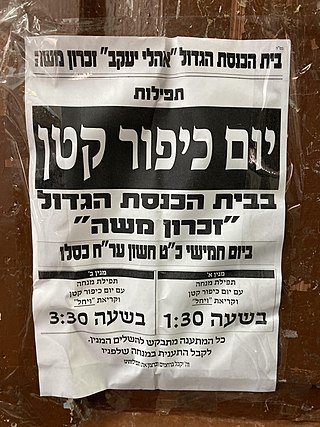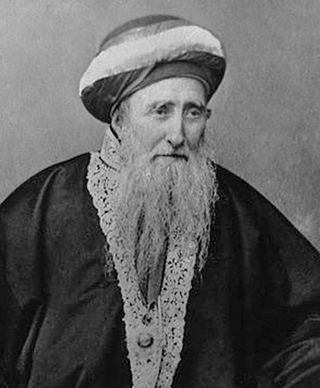
SephardicJews, also known as Sephardi Jews or Sephardim, and rarely as Iberian Peninsular Jews, are a Jewish diaspora population associated with the Iberian Peninsula. The term, which is derived from the Hebrew Sepharad, can also refer to the Jews of the Middle East and North Africa, who were also heavily influenced by Sephardic law and customs. Many Iberian Jewish exiled families also later sought refuge in those Jewish communities, resulting in ethnic and cultural integration with those communities over the span of many centuries. The majority of Sephardim live in Israel.
Kol Nidre is an Aramaic declaration which begins Yom Kippur services in the synagogue. Strictly speaking, it is not a prayer, even though it is commonly spoken of as if it were a prayer. This declaration and its ceremonial accompaniment have been charged with emotional undertones since the medieval period, creating a dramatic introduction to Yom Kippur on what is often dubbed "Kol Nidrei night", with the entire Yom Kippur evening service popularly called Kol Nidrei.
The History of Sephardic Jews in England consists of the Sephardic Jews' contribution and achievement in England.

The Dinstagishe un Fraytagishe Kuranten was the earliest known Yiddish-language periodical, founded by Uri Phoebus Halevi. It was a semi-weekly founded in Amsterdam in 1686, that was published on Tuesdays (Dinstag) and Fridays (Fraytag) and it lasted for little over one year. It covered local news and news from other Jewish communities, including those as far away as India. Issues of the paper were discovered in 1902 by the librarian David Montezinos.
Spanish and Portuguese Jews, also called Western Sephardim, Iberian Jews, or Peninsular Jews, are a distinctive sub-group of Sephardic Jews who are largely descended from Jews who lived as New Christians in the Iberian Peninsula during the few centuries following the forced expulsion of unconverted Jews from Spain in 1492 and from Portugal in 1497. They should therefore be distinguished both from the descendants of those expelled in 1492 and from the present-day Jewish communities of Spain and Portugal.

The history of the Jews in the Netherlands largely dates to the late 16th century and 17th century, when Sephardic Jews from Portugal and Spain began to settle in Amsterdam and a few other Dutch cities, because the Netherlands was an unusual center of religious tolerance. Since Portuguese Jews had not lived under rabbinic authority for decades, the first generation of those embracing their ancestral religion had to be formally instructed in Jewish belief and practice. This contrasts with Ashkenazi Jews from central Europe, who, although persecuted, lived in organized communities. Seventeenth-century Amsterdam was referred to as the "Dutch Jerusalem" for its importance as a center of Jewish life. In the mid 17th century, Ashkenazi Jews from central and eastern Europe migrated. Both groups migrated for reasons of religious liberty, to escape persecution, now able to live openly as Jews in separate organized, autonomous Jewish communities under rabbinic authority. They were also drawn by the economic opportunities in the Netherlands, a major hub in world trade.

The history of the Jews in Portugal reaches back over two thousand years and is directly related to Sephardi history, a Jewish ethnic division that represents communities that originated in the Iberian Peninsula. In the sixteenth and seventeenth centuries, Portuguese Jews emigrated to a number of European cities outside Portugal, where they established new Portuguese Jewish communities, including in Hamburg, Antwerp, and the Netherlands, which remained connected culturally and economically, in an international commercial network during the seventeenth and eighteenth centuries.

The community of Sephardic Jews in the Netherlands, particularly in Amsterdam, was of major importance in the seventeenth century. The Portuguese Jews in the Netherlands did not refer to themselves as "Sephardim", but rather as "Hebrews of the Portuguese Nation." The Portuguese-speaking community grew from conversos, Jews forced to convert to Catholicism in Spain and Portugal, who rejudaized under rabbinical authority, to create an openly self-identified Portuguese Jewish community. As a result of the expulsions from Spain in 1492 and Portugal in 1496, as well as the religious persecution by the Inquisition that followed, many Spanish and Portuguese Jews left the Iberian Peninsula at the end of the 15th century and throughout the 16th century, in search of religious freedom. Some migrated to the newly independent Dutch provinces which allowed Jews to become residents. Many Jews who left for the Dutch provinces were crypto-Jews. Others had been sincere New Christians, who, despite their conversion, were targeted by Old Christians as suspect. Some of these sought to return to the religion of their ancestors. Ashkenazi Jews began migrating to the Netherlands in the mid-seventeenth century, but Portuguese Jews viewed them with ambivalence.

Isaac Aboab da Fonseca was a rabbi, scholar, kabbalist, and religious writer. In 1656, he was one of several elders within the Portuguese-Jewish community in Amsterdam and for a time in Dutch Brazil before the Portuguese reconquest. He was one of the religious leaders who excommunicated philosopher Baruch Spinoza in 1656.
Samuel Pallache was a Jewish Moroccan merchant, diplomat, and pirate of the Pallache family, who, as envoy, concluded a treaty with the Dutch Republic in 1608. His antecedents fled to Morocco during the Reconquista. Appointed as an agent under the Saadi Sultan Zidan Abu Maali, Pallache traveled to the newly-independent Dutch Republic to discuss diplomatic terms with the Dutch against their mutual enemy, the Spanish. He died in the Netherlands, brought there due to the intervention of his ally, Maurice of Nassau, who helped him when he was arrested by the Spanish.
Caceres was the name of a family, members of which lived in Venezuela, Portugal, the Netherlands, England, Mexico, Honduras, Peru, Suriname, the West Indies, and the United States. They came from the city of Cáceres in Spain.

The History of the Jews in Amsterdam focuses on the historical center of the Dutch Jewish community, comprising both Portuguese Jews originally from both Spain and Portugal and Ashkenazi Jews, originally from central Europe. The two separate groups have had a continuing presence since the seventeenth century. Amsterdam has been called a Jerusalem of the West and the "Dutch Jerusalem". The Holocaust in the Netherlands devastated the Jewish community, with the Nazis murdering some 75% of the approximately 80,000 Jews at time present in Amsterdam, but the community has managed to rebuild a vibrant and living Jewish life for its approximately 15,000 present members.

Yom Kippur Katan, is a practice observed by some Jews on the day preceding each Rosh Chodesh. The observance consists of fasting and supplication, but is much less rigorous than that of Yom Kippur proper.

Abraham Palacci was a grand rabbi and author of Ottoman Smyrna which is now Izmir. He was the son of grand rabbi Haim Palachi and brother of grand rabbi Rahamim Nissim Palacci and rabbi Joseph Palacci. He came from the influential Pallache family.

"Pallache" – also de Palacio(s), Palache, Palaçi, Palachi, Palacci, Palaggi, al-Fallashi, and many other variations (documented below) – is the surname of a prominent, Ladino-speaking, Sephardic Jewish family from the Iberian Peninsula, who spread mostly through the Mediterranean after the Alhambra Decree of March 31, 1492, and related events.

Juda Lion Palache was a professor of Semitic languages at the University of Amsterdam and a leader of the Portuguese Jewish community in that city. He came from the Pallache family.
Joseph Pallache, was a Jewish Moroccan merchant and diplomat of the Pallache family, who, as envoy, helped his brother conclude a treaty with the Dutch Republic in 1608.
Moses Uri ben Yoseph HaLevi, also Moses Uri Levi or Moses Uri Halewi or Philip Uri Joosten Halevi [not to be confused with Moses ben Joseph ben Merwan Ha-Levi] was originally a German rabbi who become an instrumental figure and a key founder of the Spanish-Portuguese community of Amsterdam. Born likely in the German city of Wittmund, Germany or Braunschweig, in the year 1602 he became the first chief rabbi of the Jewish Community of Amsterdam. He is considered to be the founder of the first Jewish community in Amsterdam and the first rabbi of a Sephardic community in Northern Europe.
The Curiel family is a prominent Sephardi Jewish family.









